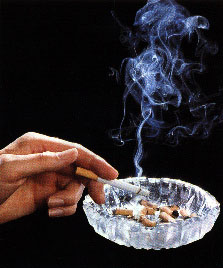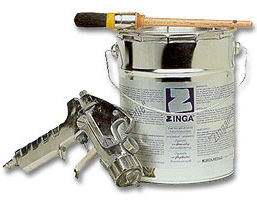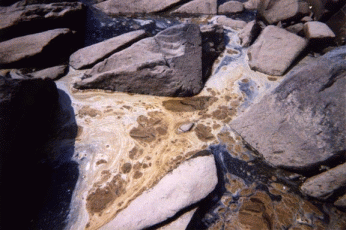Examples of pollution
- Pollution
of surface freshwaters. Any use of residential, industrial or
agricultural land will have an impact on the quality of surface freshwaters
and groundwaters. Since water is essential for all forms of life, quality
standards for the use of freshwater supplies are strictly defined by official
regulations. Drinking water must be free of toxic chemicals and pathogens
which are to be eliminated by standard water treatment facilities.
Poor quality water, which cannot enter the urban water distribution system, may be used, depending on the contamination level, in agriculture or industry, or can be classified as toxic waste which requires a special means of disposal.Fig. 1: Oily sludge dumping in a river.
(Credit: National Wilderness Institute)
Toxic heavy metals can be released from specific production processes: for example, chromium is released from tannery activities, cadmium from foundry waste, lead from the paint industry. Finally, toxic organic pollutants can be released
into the environment, and their different degrees of chemical and biological
degradability may cause damage to living organisms.
can be released
into the environment, and their different degrees of chemical and biological
degradability may cause damage to living organisms.
Examples of toxic organic chemicals found in freshwaters are pesticides used in agriculture, and detergents or surfactants, easily recognised by their characteristic foam. Some of these surfactants have been seen to mimic typical oestrogen activity on humans with the result, in the case of drinking water, of an increase in testicular and breast cancer and a decrease in the number of spermatozoa.

Fig. 2: Polluted river in U.K.
(Credit: Ben Osbome)
- Indoor pollution. Confined spaces such as houses, offices and other enclosed workplaces are characterised by important types of chemical and biological pollution
 .
.
Biological pollution refers to the presence of fungi, molds, spores, bacteria and viruses, which are examples of indoor biological pollutants. These find an ideal habitat in houses – in suspended particulate matter, house dust (host to mites and other species responsible for asthma attacks), pets, poorly maintained air conditioners and damp walls. Common health effects are allergies and other reactions of the immune system which lead to asthma, dermatitis, etc.
Added to this we can mention chemical pollution, which includes: (i) combustion products from badly-ventilated or malfunctioning heating appliances, cooking stoves and tobacco smoke, (ii) volatile organic compounds from pressed wood products, wallpaper and
common household products (hair spray, glue, cleaning agents, pesticides, etc.).
Adequate ventilation is an effective way
to maintain good indoor air quality, although
it does allow outdoor air pollutants to enter.
from pressed wood products, wallpaper and
common household products (hair spray, glue, cleaning agents, pesticides, etc.).
Adequate ventilation is an effective way
to maintain good indoor air quality, although
it does allow outdoor air pollutants to enter.
Finally, a radioactive natural gas, radon (a member of the uranium family which can cause cancer) completes the
list of potential indoor pollutants.
Because of its gaseous nature, radon,
emitted from particular types of rocks and soil, groundwater or earth-derived
construction materials, can easily infiltrate any buildings which may be above
it.
(a member of the uranium family which can cause cancer) completes the
list of potential indoor pollutants.
Because of its gaseous nature, radon,
emitted from particular types of rocks and soil, groundwater or earth-derived
construction materials, can easily infiltrate any buildings which may be above
it.

Fig. 3: Toxic and carcinogenic substances from passive smoking indoors. Fig. 4: Coatings and paint on walls and furniture, etc. release over time various volatile organic compounds (formaldehyde, solvents, etc.). 

Fig. 5: Emission of organic substances (lipids and their oxidation products) from cooking operations.
- Indoor pollution. Confined spaces such as houses, offices and other enclosed workplaces are characterised by important types of chemical and biological pollution
